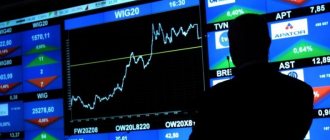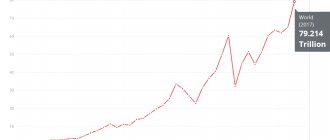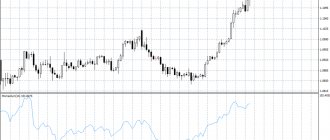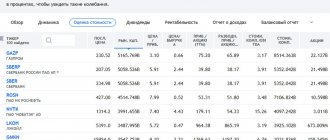Lazy Investor Blog > Stock Exchange
Now there is only talk about correction and the impending crisis. This article is about how to distinguish a correction from a crisis and whether it is worth actively buying securities in anticipation of a quick return to growth. I propose to remember how events developed in 2008 and 2018. and look for historical analogies with the situation in 2021.
Start reading with the video on my YouTube channel.
What does short trading mean on the stock exchange?
Shorting on the stock exchange is a type of stock transaction in which the investor expects to make money by reducing the price of shares borrowed from the broker. In fact, he is selling assets that he does not own. Subsequently, the investor returns them to the broker, but at a lower cost, keeping the difference for himself.
In simple words, the game for a fall is called “short”. The derivative word of this term is the English word short, which means “short”. In colloquial market slang there are such variations: short transaction, short position (sale or transaction), short sale and others.
In the bearish game, various trading instruments and their derivatives can be used (securities, futures, options, etc.), but the main principle of the bearish game on the stock exchange remains unchanged: earnings when quotes fall and losses when prices rise.
Let's look at the essence of a short position using an example.
According to the investor's assumption, the price of Alrosa securities (ALRS) will decrease. By borrowing 150 shares of Alrosa (ALRS) from your broker in the amount of 15,000 rubles. (at 100 rubles per 1 c.b.), he sells them at the current cost. At the time of sale, the trader incurs a debt to the broker in the amount of 150 ALRS shares.
After waiting until the quotes drop, the investor purchases securities for 70 rubles in order to return them to the broker, leaving the difference of 4,500 rubles as profit. (RUB 15,000-10,500).
By signing an agreement with a broker, the investor automatically receives the opening of a short position. If the application or terminal does not allow you to sell assets, then contact technical support.
Now that you understand how the process of making money by going down on the stock market works.
Bearing the stock market: Rules
Although this process is intuitive, it is still better for a novice investor to become familiar with the rules for opening short positions in the market:
- Before opening short trades, long-term positions must be closed , since it is impossible to conduct short and long trading on the same shares at the same time.
- Not all securities offered on the stock market can be shorted. Those that meet the requirements of the Federal Financial Markets Service are suitable for this operation. The Federal Service determines a list that includes the most liquid shares of the largest Russian companies: blue chips, the first echelon and some assets of the second. The broker has the right to lend to the client only shares included in the FFMS list. He is prohibited from providing other assets for such transactions.
Find a list of which shares you can sell on the broker's website. The Finam company has them in the “List of Margin Securities” section.
At first glance, this is a simple and understandable procedure. But playing short for ordinary traders carries significant risks. After all, none of them can know absolutely exactly where prices will move. It is recommended only for experienced investors who consciously take risks and are prepared for possible drawdowns, and not just for making a profit.
- In the Quick terminal, you can check for open short positions , which are displayed with a minus sign. If, for example, a broker lent a client 150 shares, the latter's balance would show -150 shares.
- An investor can use leverage to increase profits. But at first it is better to trade using only personal funds.
- Each asset that is allowed to be shorted has its own risk rate. It affects the amount of leverage. A list of stocks available for short trading and their corresponding risk rates can be found on the broker's website or is available upon request.
Commissions
- When a transaction is opened and closed within one trading day (intraday), brokers do not impose additional commissions on it.
- In the case of an overnight transfer, a fee is charged for the use of the borrowed assets. These percentages are calculated in accordance with the terms of the tariff of the selected broker. On average, it is about 14% per annum of the loan amount. The equivalent of a daily write-off is about 0.03835% (1/365 * 0.14) or 5.75 rubles. (RUB 15,000*0.3835%). If the trade is held for a couple of days, the commission will be 11.5%.
- It is worth considering that at the end of the trading day on the Moscow Exchange, quite often the market rises . This is due to the fact that traders who waited until the last moment are covering their shorts.
- Transferring a position is almost always associated with great risks , since unexpected news may appear overnight, under the influence of which there will be a morning gap between transactions (gap).
It is also worth considering possible risks before entering a trade.
Stock market decline: answering 9 most common questions about the current situation
2. What will happen to markets in the future? Will market prices continue to fall?
In fact, at the moment no one can answer this question, since there are no historical analogues. We are witnessing an extraordinary situation in the markets, and it is impossible to predict what will happen in the future in the short term, nor is it difficult to predict whether the market will show further decline. What can be said with confidence is that all crises end sooner or later, and this one will end too.
Short periods of recovery in stock prices are possible, but our analysts do not expect a rapid normalization of the situation on the stock market while the risks associated with the spread of the virus remain high.
Once the coronavirus situation is under control, the market will begin to recover, showing a steady upward trend. 3. What do mutual fund managers do when the stock market declines?
A team of portfolio managers is closely monitoring developments. For funds that hold multiple asset classes, the proportion of risk assets has been reduced in favor of more conservative instruments. At the same time, it is necessary to understand that a decrease in the value of assets is still possible. In addition, Fund Rules severely restrict portfolio managers. The fund must contain the types of assets stated in its description. In other words: a stock fund must remain a stock fund. The rules of the fund can be found on the website of the Manager ]in the “Information Disclosure” section[/anchor].
4. Can I access my money at any time?
Of course. We do everything in our power to ensure that transactions take place within the time frame that is customary for our clients. You can receive money from the sale of assets at any time, but you need to remember that the price will be fixed at the time of sale, taking into account the decrease in value in recent months.
5. What should I do now? Should I continue investing despite the market decline or should I sell my assets?
Selling assets on decline is most often a bad idea. You invested money for a certain horizon with a certain risk. Answer this question: How does the coronavirus situation affect your investment horizon or risk attitude? If you urgently need cash or are not prepared for a sharp decline in your investments, your portfolio needs to be reviewed. If nothing has changed, then there is no need to make sudden movements. For example, if you have been investing in stocks for the long term, then locking in the current result on the downside may not be the best decision.
Historical data shows how maintaining investments or selling them on emotions during crises affects the results. This is clearly visible in the graph:
The dynamics of the S&P500 index - SPX Total Return (including dividends in dollars) from December 31, 2007 to March 31, 2021 was taken as the underlying asset for the calculation. Source: Bloomberg
The last major stock market crash, the Global Financial Crisis, occurred in 2008. Prices then fell by almost 50%. This decline was almost completely compensated for over the next three years. From then on, the upward trend continued until prices rose another 150%.
Anyone who sold assets at the bottom of the chart in late 2008/early 2009 effectively recorded a loss. If we simulate the situation that a year after the sale of assets there is a new purchase, then in this case it was possible to get solid growth. However, the result was much lower than that of investors who did not withdraw assets throughout the crisis. From this we can conclude: it is impossible to determine the best entry point, since, given the general uncertainty, it is almost impossible to predict market movements.
While examples such as these are illustrative, past performance does not allow reliable conclusions to be drawn about the future. One thing is for sure: fear is a poor guide when it comes to making investment decisions.
6. What does the current stock market crash mean for those who invest on a regular basis?
If you build savings by investing a fixed amount with a certain frequency, the current situation is in your favor. The cheaper the assets at the time of purchase, the more you purchase by averaging the price. While there is potential for further declines, this represents an opportunity to further benefit from a potential long-term market recovery. This effect can be enhanced by temporarily increasing the amount of additional purchases while the market has not recovered from the crisis and assets are cheap.
7. It is often repeated that markets will recover – what is this confidence based on?
Stock market crashes or capital market crises are an integral part of the investment process.
The chart below shows the historical performance of the S&P 500 US broad market index, including dividend payments, since 1988.
Over the past 30 years, the global stock market has experienced more than 20 different crises. Some had more consequences, some less. But all these crises have one thing in common: subsequent recovery. And despite all these price declines, the stock market has shown growth over the past 30 years. For example, the American market grew on average by 9.28% per year in dollars.
Our opinion is this: like all past crises, the current one will also pass, and when this happens, the market will return to growth again.
8. I see a negative result in my portfolio. Does this mean I'm losing money? How can I correctly evaluate the current result?
It all depends greatly on when and in what assets you invested. For some, the current decline threatens only a drop in overall profitability. Someone who has invested very recently may immediately see a negative impact on their investment portfolio. But the decline is only on paper. You still own the assets. Their value has temporarily decreased in response to the coronavirus pandemic, widespread quarantines and related problems. It will take some time for the market to return to growth again. This recovery will also lead to the growth of your assets. If you sell all assets now at current prices, then the loss, which now exists only on paper, will become real.
9. Is it worth investing your free money now?
Buying assets that have fallen in price is a good opportunity for an investor. However, the decision whether to invest now or not depends on your attitude to risk, as the market situation remains uncertain and volatility can be expected to continue. If you are already an experienced investor and are looking for the optimal moment to invest your free money, then our advice is not to look for this moment, but to make regular purchases, distributing the amount into several parts. Remember that the implementation of an investment idea may take longer than expected, and you should always have a financial reserve.
If you have any questions about your investments or the stock market, please contact us. We will always be happy to help.
Telephone contact from Monday to Friday from 9.00 to 18.00 Moscow time
We remind you that in the current situation, we recommend that our clients, if possible, refrain from visiting the Bank’s office and make maximum use of the capabilities of remote service channels through their personal account on the Management Company’s website.
Take care of yourself and your loved ones!
Any estimates, information, forecasts related to the activities of other financial organizations and institutions, other organizations and institutions and their products, disclosed (provided) by Raiffeisen Capital Management LLC, express exclusively subjective assessment of Raiffeisen Capital Management LLC of the situation in accordance with information obtained by him on a legal basis, the source of which, in the opinion of Raiffeisen Capital Management LLC, is trustworthy. The final conclusions should not be based solely on the assessment (forecast) of Raiffeisen Capital Management LLC, but should also indicate the inevitability of their implementation.
The information disclosed, unless otherwise expressly stated, does not constitute individual investment advice. Investment products of Raiffeisen Capital Management LLC may not be suitable for a particular person.
Raiffeisen Capital Management LLC, unless otherwise expressly stated by it and (or) expressly provided for by the current legislation of the Russian Federation, does not give any guarantees and (or) representations and does not accept any responsibility in relation to the financial results obtained based on the information disclosed (provided) by him. Raiffeisen Capital Management LLC recommends not to rely in the process of making an investment decision on any information disclosed (provided, published) by it as the only source of information required (necessary) for making an investment decision.
The information presented does not constitute an individual investment recommendation, guarantee and/or promise of future performance (return on investments), is not a forecast of events, investment analysis or professional advice, and is not intended to be an advertisement, placement or public offering of any securities, products or services.
Bearing the stock market: risks
- If an investor has purchased a stock and its price declines, he can wait out the drawdown period. When you open a short position, you must either trade or close your positions. An open transaction for 5-7 days is unprofitable, since a commission will be calculated daily.
Short selling is designed for a daily (maximum weekly) time period to avoid loss of profit due to overhead costs.
2. The absence of limitations on potential losses is an equally significant factor in a short position. If a speculator bought shares with his own funds without using leverage, his losses may amount to the size of the transaction, that is, the cost of the purchased shares.
The peculiarity of such transactions is the fact that you can only win an amount not exceeding the value of the share. For example, if you short a security whose value is, for example, $150, then the maximum amount the trader will receive upon winning will be $149.99. While the income from the acquisition and long-term holding of individual securities has no limit. Assets may rise or fall. But their growth when investing for a long period will allow you to earn from 100% to 200%, possibly higher.
But in a bearish game, if stocks rise, potential losses can easily exceed 100%, and amount to 200-300% or more. It’s good if the shortist has set a stop loss.
Stop Loss is a value at which assets are automatically sold, which limits the loss of funds.
For clarity, consider Tesla shares, which have grown by more than 600% in 5 months since the stock market crash in March 2021 (from $255 to $2,297).
Risks increase if leverage is used to purchase shares. Such shorting incurs big losses.
3. Averaging of unprofitable positions by many newbies leads to the loss of the entire deposit. Professional speculators rarely average.
But this type of stock trading also has advantages.
What is correction?
Correction (rollback) is a change in stock or currency prices in the opposite direction to the trend.
Typically, this phenomenon occurs because a particular security or currency is “overbought” or “oversold.” Other reasons include the lack of people willing to trade at that price. From another point of view, a correction occurs due to a large number of stop orders, which make it profitable for the price to move in the direction of their execution, after which the price returns to the main trend. Additionally, a correction is defined as a 10% decline in one of the major US stock indexes (S&P 500 or Dow Jones Industrial Average).
If we talk about significant market corrections, then from 1980 to 2018. There were 36 corrections on the American market. Of these, only 5 moved into “bear markets”, that is, they declined for a long time. This brought a lot of grief to investors who found themselves in long positions at those moments. It turns out that about 86% of declines are normal corrections, and the market subsequently recovers successfully. But in the remaining 14% of cases, the fall is more serious and prolonged.
In February 2021, the US stock market began to correct again as investors sold off stocks in favor of safer assets due to news about the spread and potential impact of the coronavirus.
Historical analysis of previous corrections suggests that in such situations the market could fall by 13%. As a rule, after corrections it takes about four months for it to recover to its previous level.
But there is one “BUT” here. This only happens if the stock does not enter a bear market, falling 20% from its high. If losses stretch to 20%, then there are painful consequences ahead and more time for recovery.
Pros of short positions
Short trading has the following advantages:
- Getting quick profits;
- The opportunity to earn money not only when the stock price rises, but also when it falls,
- Possibility of hedging long positions during drawdowns.
If the first 2 are obvious, then the 3rd advantage is not used or overlooked by many. Therefore, let's look at this process in more detail.
Hedging is a tool of trading strategies that allows you to insure risks that arise in the market. Simply put, it is an agreement for the future sale or purchase of any securities at a certain price. The purpose of its conclusion is to minimize risks from price dynamics. Thus, the investor knows the future value, which allows him to insure himself against unexpected fluctuations.
As an example, it is worth considering the purchase by investor A of Gazprom assets . These securities are attractive for long-term investment, but are expected to fall in value when playing for a short or medium period. To avoid wasting time during the drawdown, the investor opens a short contract on a futures contract for Gazprom assets, which will allow him to hedge risks and earn extra money.
Where did the myths about the stock market come from?
As a rule, money is lost for a standard set of reasons arising from the trader’s unpreparedness to work in the financial and commodity markets. Here, in addition to knowledge, psychological transformation of the individual is required. However, brokers, whose earnings depend on clients paying commissions for each open trading order, begin to convince the client of the wrong choice:
- Strategies
- Instrument
- Market
The last argument is an echo of the struggle between brokers for the client. Each company specializes in one of the markets, for example, stock or derivatives (futures and options) due to separate licensing. The Forex market stands alone on this list: firms offering currency speculators trading services in currency pairs and CFD contracts can open a business according to a simplified scheme, using offshore registration.
Forex is decentralized, unlike stock, commodity and derivatives markets, which are tied to specific exchanges. These platforms have strict government regulation and impose increased, and therefore costly, requirements on brokers. The most expensive license for trading securities is, and by a “strange” coincidence, it is the stock market that is considered “the most profitable for traders, where it is impossible to lose money.”
Disadvantages of Shorting Stocks
Playing short has a significant drawback - the risks of short positions are much higher when comparing them with long-term ones.
Let's compare. Purchasing securities on the stock exchange is accompanied by 2 main risks:
- Bankruptcy of the company and complete loss of 100% of money. But if the assets are provided by reliable issuers, this is unlikely.
- The stock price goes lower than it was when purchased. In this case, the investor waits out the drawdown or closes the transaction, incurring losses. He makes all decisions himself. The broker cannot close the client's long position if the latter has no debt obligations. The depositary is responsible for accounting for securities - an independent organization that controls transaction procedures and the transfer of ownership of assets from one owner to another. Regardless of the situation, the investor remains their owner.
Things are completely different when there is a bearish game on the stock exchange, when the trader uses borrowed assets. If the price goes up and there are not enough funds in the client’s account, the broker can issue a warning to him and resort to forced closure of all positions. In such a situation, waiting out the drawdown is not economically profitable.
In this regard , before opening a short position, even check the deposit for the presence of free funds in an amount that allows you to survive the drawdown.
Margin call
In addition, the broker may make a demand to the trader to close a transaction or to replenish the account in order to cover losses (margin call). This can happen if the amount of funds in the latter’s account approaches a critical level . It will not be enough to purchase and return borrowed assets. The investor must prove to the broker that he has the amount that will cover temporary losses by replenishing the account with cash. Regardless of the outcome, the broker does not face risks, since he can forcefully close the trader’s positions at any time. It is better that the situation does not reach the point of a “margin call”, since the loss will constitute a significant part of the deposit.
In this regard, it is important to choose reliable and trusted brokers. I invest in shares of Russian companies through the broker BKS, foreign ones through Roboforex.
Correction: definition and signs
A correction is a moderate price movement against the trend. Formally, this could be a decrease in quotes against the backdrop of stable growth, or their positive dynamics after a protracted fall. However, this term is more often used when the chart moves down.
To be able to talk about a correction, a drawdown of more than 10% is required. However, its value should not exceed 20% of the values preceding the recession. There is also an opinion that this term is applicable as long as quotes are above last year’s level. As soon as the price of most assets falls lower than it was exactly a year ago, stock market players begin to prepare for the transition to a protracted bear market phase.
There are several additional signs:
- The first wave of selloffs often occurs after consolidation at the highs. It is not provoked by real negative news, but by its anticipation.
- Volatility increases. Falling prices give way to attempts to rise. The spread between the intraday high and low reaches 10%.
- The forecasts given by eminent experts turn out to be diametrically opposed to each other.
- On the quote chart you can clearly identify several waves of decline (most often two). Moreover, the latter is deeper than the previous ones.
Within the framework of technical analysis, it is generally accepted that a sharp drop in quotes was a correction, and not a crisis, if it stopped after reaching the 200-day average price. This is due to the fact that many exchange players perceive this value as a strong support level and consider it the optimal entry point into a sagging asset.
I also recommend reading:
Why does an investor need to know a company's free cash flow?
What an investor needs to know about free cash flow
Based on market analysis over the past 10 years, the following average correction parameters were derived:
- duration 71.6 days;
- drawdown 15.6%.
If there is a decline in quotations, then it is impossible to say immediately what status it will receive. That is why not all investors are in a hurry to use the correction to build up positions. Cautious players prefer to enter cash or defensive assets. They remain in them until the uptrend begins.
Short and Dividends
Dividends are a company's payment of part of its profits to its shareholders. This is a good way for investors to receive additional income on the stock market not from the revaluation of purchased securities, but from participating in the profits generated by the company.
For the payment of dividends, the day on which the register of shareholders is compiled (cut-off) is determined. Usually after it the price of assets goes down by the amount of dividend paid to shareholders. This situation is called a dividend gap. Inexperienced traders assume that this is a great way to make money, since the date of compilation of the register is known in advance. They think that by opening shorts during the dividend cutoff, they can make a good profit (sell assets before it, and after the gap, when they fall in price, buy them back and return them to the broker).
Such trading is accompanied by great risks. The fact is that an investor from whom the broker borrowed dividend securities will not be able to receive dividends, since his assets have been sold. To eliminate this injustice, the broker withholds funds from the shortist's account, the amount of which is equal to the amount of dividends for the original holder of the shares. This situation shows that you should not open a short sale of shares before accruing dividends. Although it is possible to make money from their fall (if the exchange rate falls by more than the amount of dividends), in reality, the short seller closes the position with a loss in 90% of cases.
The Myth of Transparency in Futures and Options Trading
The high percentage of traders going broke on futures is forcing companies to come up with other ways to attract customers, without promising “win-win grails.” Newcomers are told about the transparency of the bidding process. Futures contracts are traded on the exchange, where each participant in the “glass” observes his own submitted pending order and sees its execution in the “Feed of all transactions”.
The problem is that transparency of trading is a clear reason for manipulation: the exchange openly leaks information about the levels of pending orders and the size of orders to specially hired market-making companies. Traders gave them an apt name - puppeteers.
The specifics of their work provide not only an advantage in information about the “market map”, but also access to large financial resources placed in trust by many large and small clients.
The client is also told about government supervision, without going into the history of the hundred-year unsuccessful struggle of government agencies against broker cartels, which is difficult to prove and difficult to bring to court. And even when this is successful, the case still ends in a fine that is not comparable to the earnings from the manipulations.
A beginner or a professional trading futures ends up on the market-making conveyor belt - a large-scale kitchen where brokers use the following strategies against clients in an organized manner:
- Coloring the tape - many transactions in small lots to create the illusion of activity on the instrument, attracting scalpers to create a trend in the instrument. Used to create high demand to “distribute” previously purchased large volumes before a market reversal;
- Phantoms in the glass or “overflows” are fictitious deferred or real “contractual” transactions in order to stop an undesirable trend, “scaring” Sellers or Buyers who will believe in the reality of counter-transactions or opposite demand, take profits and leave the market;
- Gap – promotion of supply or decrease in demand to create a price gap on the chart, sharply changing the cost of the futures for one tick;
- Collecting the order book is a preliminary calculation and a sharp release of transactions at the highest market price, exceeding in volume all the nearest pending orders in the order book. The impulse attracts Buyers or Sellers working on a “breakout” strategy, but they become victims of a pre-planned “reset of the order book” in the opposite direction;
- Manipulation with the futures opening price level - placing orders in the premarket at inflated volumes in order to fix the price of the first transaction from the market opening at the desired level;
- Corner – an agreement with partners on the assignment of dominant volumes in the underlying asset for the purpose of manipulating the price of futures;
- Squeeze is the reverse operation described above - taking a selling futures position in conditions of shortage of the underlying asset in order to satisfy the client’s demand for a short position (borrow shares for sale);
- Controlled flat – trading an asset within certain price limits before the expiration of futures or options in order to maintain the required level of contract execution prices;
- Artificial backwardation or contango - market makers prey on arbitrageurs who trade without stops, selling and simultaneously buying futures on the same asset with different expiration dates. The strategy is considered risk-free, since the price difference at the beginning of the contract is equalized at the time of expiration;
Unlike the futures and options market, which are often collected on one site, the Forex market is completely decentralized and the exchange rate is formed by recording information on real transactions from many large banks.
How to make money from falling stocks 2021
To make money from falling stocks, the only and main requirement is adequate market analysis. To open a sell position, there must be a sell signal obtained based on technical analysis on a short time frame (up to H4), preferably confirmed by a 4-hour or daily chart. For those who follow fundamental stock analysis, it is important to timely assess upcoming news.
If the stock does not behave as predicted, the short seller will lose money, so setting a Stop Loss is mandatory.
I don't often bet on stocks going down, and the main pattern for opening a trade is the Hammer candle. Let's go back to the Tesla stock chart.
In the 1st case, earnings exceeded 4500 points after sitting out the weekend, in the 2nd option the profit during the week amounted to 8300 points, the 3rd option brought 4500 points. arrived in 1 day.
- Roboforex Stock
- FxPro
Roboforex Stock - with minimal commissions for purchasing foreign shares
- 15 years in the stock market,
- $100 is the minimum deposit,
- 95% positive feedback,
- Access to American and European stock markets,
- Free stock trading training course,
- Dividend payment,
- Current trading ideas for investment,
- Free demo account with the ability to test robots.
FxPro is the best in CFD trading and execution speed
- Shares of leading companies in the USA, England, France and Germany,
- 1:25 — leverage for buying shares,
- Trading in the familiar MT4,
- 11 milliseconds - average execution speed ,
- Dividend payment,
- Withdrawal of funds without commissions
- You can make money when stocks fall.
In conclusion, I would like to note that short trading on the stock exchange is a very real way to make money , and many people I know make good money from this. However, before each trade, it is important to evaluate the potential risk-to-reward ratio and place limiting orders.
I recommend reading:
- Investments in shares,
- Where to invest money at high interest rates,
- Locking positions on Forex











